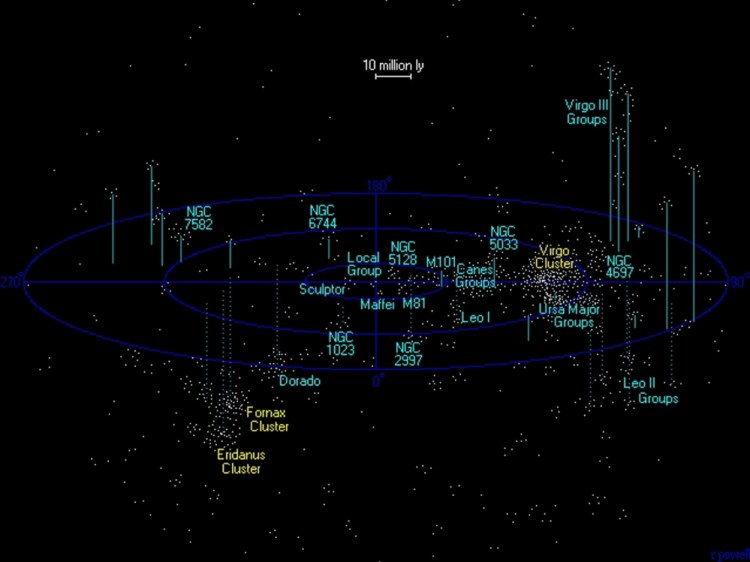In the 1980s, the phrase “billions and billions of stars” came to life through Carl Sagan and became what we nowadays call a meme — a commonly used image or figure of speech that has not yet become a meaning-mangling cliché.
Sagan was talking about how the practically limitless number of stars in the Milky Way galaxy, where we live, imply a practically limitless number of possibilities for wonder, awe, investigation, and life itself.
How else could you say it? There are around 100 billion stars here, and possibly 400 billion — almost inconceivably huge numbers, despite the ease with which they spew out of Washington. One million, after all, is 1,000 thousands, and a billion is 1,000 millions (1,000,000,000). And just to keep the sequence going, 1 trillion is 1,000 billions.
All the individual stars you can pick out by eye from Earth amount to about 6,000. Then there are these other washes of light, which when you look at them through binoculars or a telescope turn out also to be made of stars.
One of those washes is the band of the Milky Way itself, stretching roughly north to south on summer evenings. These are the stars seen looking through the plane of our galaxy, which is about 100,000 light-years across. Several galaxies outside the Milky Way are also visible by eye from Earth. Two are the Magellanic Clouds, which we can’t see here in the Northern Hemisphere. They lie about 160,000 and 200,000 light-years away. The Small Magellanic Cloud contains around 3 billion stars, and the Large around 30 billion.
If you know where to look on a dark fall night, you can spot in the constellation Andromeda a faint wisp known as M31. This is a galaxy like ours, probably a bit larger, with 400 billion to maybe even 1 trillion stars. It’s about 2.5 million light-years distant, and is one of the three large galaxies in the Local Group, which includes several dozen galaxies within a sphere about 5 million light-years in diameter. The Milky Way and M33 in the Triangulum constellation are the two other large ones.
Our Local Group, it turns out, is not much more than a speck in the galactic neighborhood. Nearby is a larger cluster of galaxies known as the Virgo cluster. The Local Group and the Virgo cluster lie in a region containing more than 50,000 galaxies in about 200 different groups, including, just to name a few, the Fornax Cluster, the Eridanus Cluster, and the Ursa Major groups. This large group of groups of galaxies is known as the Virgo Supercluster.
The Virgo Supercluster is one of three main aggregations of galaxies (the other two are the Hydra-Centaurus Supercluster and the Pavo-Indus Supercluster) made up of about 300 to 500 clusters within a span of about 500 million light-years, known all together as the Laniakea Supercluster. Laniakea is one of several large superclusters that include the Shapley, Hercules, Coma and Perseus-Pisces superclusters.
Remember we are talking not about clusters of stars, but about clusters of clusters of galaxies.
The clusters of galaxies are arranged roughly in filaments, like large organically shaped tendrils through large voids where no galaxies are seen, although it is not understood why. The galaxies are in motion, and many of them are flowing toward a region in the Hydra-Centaurus supercluster known to astronomers as the Great Attractor.
The edge of the whole universe as science describes it in 2015 appears to be around 13.7 billion light-years away. This figure is reached by calculations based on the fact that the whole enormous thing is expanding. The farther out the telescopes detect, the faster everything is moving outward. The most distant galaxy identified — if that’s what it is — is around 13.1 billion light-years away. At these reaches, the scientific description has long since ceased to refer to miles or whatever of space, but to spans of time. A light-year is the distance light travels in one year at a speed of 186,000 miles per second.
What the telescopes detect is light from activity taking place 13.1 billion years ago.
How many galaxies are there in this bewildering vastness? The recent estimates say there seem to be around 200 billion to 225 billion galaxies — galaxies, not stars. But most astronomers also seem to think this estimate is low because there are good reasons to think a lot of galaxies are missing from the observations.
From billions and billions of stars in the 1980s, to billions and billions of galaxies in the 2010s. Everything is expanding. It is all, to borrow a term from religious philosophy, unspeakable.
A very beautiful video showing how the galaxies are arranged, “Cosmography of the Local Universe,” is online. Very clear maps can be seen at the Atlas of the Universe website,www.atlasoftheuniverse.com.
Dana Wilde lives in Troy. His writings on the stars, planets and galaxies are collected in “Nebulae: A Backyard Cosmography,” available from online booksellers or by contacting the author at naturalist@dwildepress.net. Backyard Naturalist appears the second and fourth Thursdays each month.
Send questions/comments to the editors.





Comments are no longer available on this story